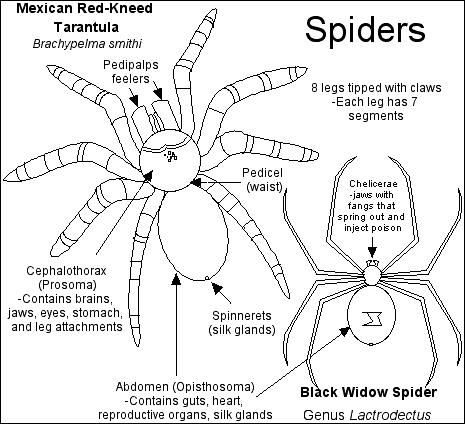|
|
Canku Ota |
|
|
(Many Paths) |
||
|
An Online Newsletter Celebrating Native America |
||
|
November 3, 2001 - Issue 48 |
||
|
|
||
|
Spiders |
||

| There are many different types of spiders that live all over the Earth in practically
every type of habitat. They come in colors including black, brown, white, gray, red, yellow, green, and orange.
Most spiders live for about a year, but the tarantula can live for 15 years. Spiders range in size from barely
visible to many inches across Spiders are arachnids (and not insects); they are related to scorpions and ticks. Young spiders are often cannibals (they will eat each other), and females often eat the male after mating. Spiders are carnivores (meat-eaters); most eat insects (like moths and crickets), but the larger spiders, like tarantulas, will eat small animals. Webs: Spiders produce silk in abdominal glands (called spinnerets). Spiders use silk to make webs and traps (for catching prey), shelter, life lines, cocoons, and diving bells (for those spiders who hunt underwater). The tips of the spider's legs are oily; this oil keeps them from getting trapped in their own webs. Weight for weight, spider's silk is stronger than steel. Anatomy: All spiders have eight legs; each leg has 2 to 3 tiny claws at the end. They have a two-part body and strong jaws (usually with poisonous fangs). They have a hard exoskeleton and not an internal skeleton. Life Cycle: After mating with a male, the female spider produces an egg sac that can contain up to a thousand tiny spider eggs. The egg sac is made of silk, and the color varies from species to species. In some species, the female spider carries the egg sac on her spinnerets or in her jaws until the eggs hatch. In other species, the egg sac is hidden under a rock, attached to a plant stalk, or encased in a web. Tiny spiderlings (baby spiders) hatch from the eggs - they look like tiny versions of an adult spider. Some spiderlings are on their own and receive no care from their mother. Other spiders climb onto their mother's back after hatching, where she feeds them. In some species, the mother dies when the young are ready to go off on their own, and the spiderlings eat her carcass. Copyright ©1999-2001 EnchantedLearning.com - We encourage printing this page for non-commercial educational use! |
|
|
||
|
|
||
| Canku Ota is a free Newsletter celebrating Native America, its traditions and accomplishments . We do not provide subscriber or visitor names to anyone. Some articles presented in Canku Ota may contain copyright material. We have received appropriate permissions for republishing any articles. Material appearing here is distributed without profit or monetary gain to those who have expressed an interest. This is in accordance with Title 17 U.S.C. section 107. | ||
|
Canku Ota is a copyright © 2000, 2001 of Vicki Lockard and Paul Barry. |
||
|
|
|
|
|
The "Canku Ota - A Newsletter Celebrating Native America" web site and its design is the |
||
|
Copyright © 1999, 2000, 2001 of Paul C. Barry. |
||
|
All Rights Reserved. |
||
